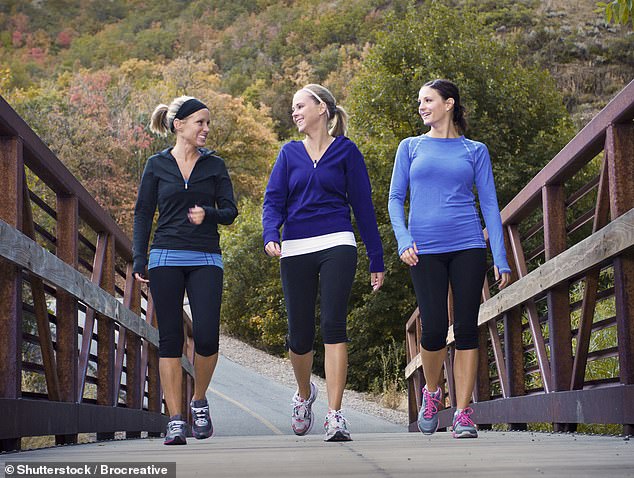Exactly how many calories you’ll burn by running one mile, based on your weight and pace… and it’s more than you think
It is common knowledge that going outside for a walk is good for you.
It has been shown to lower the risk of several chronic diseases, from diabetes to heart disease.
And getting up for a walk during your lunch break can prevent an early death and lower blood pressure.
This is because you burn calories with every step you take, reducing the risk of weight gain that can lead to obesity.
However, experts have found that the amount you burn depends on your weight, how fast you go and additional challenges such as climbing hills.

Walking is an aerobic exercise that has been shown to lower the risk of chronic health problems such as heart disease and diabetes
Now experts have created a handy calculator to work out exactly how many calories you’ll burn during a one-mile walk.
Dr. Heidi Moawad, a neurologist at Case Western School of Medicine, calculated Very good how many calories adults can expect to burn while walking a mile, depending on their weight.
The maximum is somewhere in the neighborhood of 200, the equivalent of four Chips Ahoy! cookies, and a little less than a McDonald’s hamburger.
Dr. Moawad, whose calculations were also reviewed by a dietitian, estimated calorie consumption for adults weighing between 100 and 300 pounds.
This is based on a moderate to brisk walking speed, which is approximately 2.8 to 3.5 miles per hour.
The team found that you can burn 160 calories in one go by walking a mile at a moderate pace – about 2.8 to 3.2 miles per hour.
This is how fast you go when you catch up with a friend or take your dog for a walk around the neighborhood.
| Weight in pounds | Moderate walking pace | Brisk walking pace |
|---|---|---|
| 100 | 53 calories | 57 calories |
| 120 | 64 calories | 68 calories |
| 140 | 74 calories | 80 calories |
| 160 | 85 calories | 91 calories |
| 180 | 96 calories | 102 calories |
| 200 | 106 calories | 114 calories |
| 220 | 117 calories | 125 calories |
| 250 | 133 calories | 142 calories |
| 275 | 146 calories | 156 calories |
| 300 | 160 calories | 171 calories |
At this pace, it will take you about 20 minutes to walk a mile.
However, if you are thin or underweight, don’t expect this number to be that high.
Depending on height, most adults who weigh between 100 and 120 pounds can burn about 50 to 65 calories walking at a moderate pace.
The more you weigh, the more calories you’re likely to burn.
This is because the more you weigh, the more energy your body needs to function.
This means that someone who is heavier will likely burn more calories than a thinner person doing the same level of exercise.
Men may also see a faster calorie burn than women because they naturally have a higher metabolism as a result of having more muscle than fat compared to women.
The average American woman weighs about 170 pounds, while the average man in the US weighs about 200 pounds.
By Dr. Moawad’s calculations, the average American woman will burn about 90 calories during a one-milk walk, while a 200-pound man will burn about 100.
And adults who weigh between 250 and 300 pounds can burn about 133 to 160 calories during a one-mile walk at a moderate pace.
However, brisk walking could strengthen these measures.
A brisk walking speed is about 5.5 miles per hour, and it would take about 17 minutes to reach the one-mile mark at this speed.
Walking faster can lead to burning more calories, although the differences are small.
Someone between 100 and 120 pounds may see a slightly higher calorie burn at this pace, with about 57 to 68 calories burned per mile.
Meanwhile, the average man and woman would see about 90 to 102 calories burned.
And someone who weighs 300 pounds and walks briskly can expect to burn 171 calories per mile.
Dr. Moawad also noted that adding hills or walking on an incline could lead to more calories burned, potentially bringing the total calorie burn to around 200.
“You could walk in hilly areas instead of flat areas, or you could set your treadmill to a higher incline while you walk,” she wrote.
Walking speed depends on several factors.
a 2020 studyfor example, suggested that age, gender, height, weight and overall fitness can contribute to how fast you go.
In addition, a study has been published in the journal PLOS One found that walking pace tends to slow as you get older.
The team found that most people walk about 1.2 minutes slower each year after age 60.
